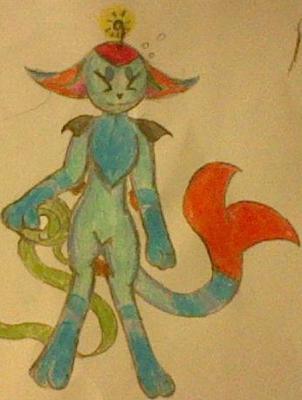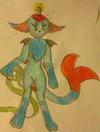Typlings
by Maggie Horton

Land Typling
Though originally once believed to be aliens, Typlings have lived and thrived on this earth for centuries. They are normally shy creatures and few have ever seen them. But once every year around the time of the 4th of July, big colonies of them come from out of hiding and they gather together on beaches and forests to sing. Their song is a melodic sad tune and those who are lucky enough to hear it often go insane.
There are two different species of Typlings - one on land and one in sea. Not much is known about the two besides the fact that they share the same horn like structures by their ears and both have a single long glowing orb antenna protruding from their forehead. Both types standing about five feet tall - they in a way closely resemble animals.
Land Typlings: Usually a brown or gray color, the flat skin-like horns connected to their ears is usually a red with a green outer structure. Their antenna glows dimly and travelers often mistake the glow for that of a firefly. They have darker tufts of fur on their shoulders, knees, elbows, and long fluffy ears.
Little is known about their eye color - those who claim to have seen one say they have no pupil and are just white. They have a long thin tail that ends with the same fluff that is on their shoulders, knees, and elbows. There is little visual difference between male and female.
How either land or sea Typlings reproduce is unknown. They are hard to spot as their fur blends in with the forest environments they have made their homes over the centuries.
Sea Typlings: Though similar to land Typlings Sea, Typlings live under the water. It has been proven however that they can walk along the land and how they breathe under the water is a mystery. There have been more sightings of sea Typlings then there has of land as sea Typlings are more social and will often come from the dark depths they usually dwell in to play with other creatures.
Both sea and land both make around the same noises, which have been recorded as clicks, screeches and occasional "Bloops". Their song is also similar, but the sea Typlings normally sounds happier leading some who didn't suffer mental illness from it to believe that land Typlings are unhappy in their homes.
Unlike land Typling's darker browns and grays, sea Typlings usually are neon greens and blues with pink replacing the land's red horns. Instead of tufts on their shoulders, sea Typlings have black fins which they use to help themselves swim. On both their elbows and knees they have orange fins and instead of being thin, sea Typlings tails are thick with an orange tail-fin.
They seem to have pointed teeth but like the land Typlings what they eat is undetermined. Their antenna glows brightly. There is reason to believe that they use this in the dark depths to lure fish closer but we cannot be for sure. Fishermen have reported catching these creatures when they fish late at night. Sea Typlings have webbed toes and a hard red boney head between their ears of which their antenna protrudes from.
There is still however much to be discovered about both species of Typlings. Little is known about how they make their homes, how they reproduce, what they eat, why they sing, and how to tell apart gender.
In the future there is hope more will be found out about them but until then, this is all that can be known. There have not been sightings of younger Typlings so we cannot be sure if they reproduce at all. We are not sure where they came from or how. Things like that can only be told with time.



